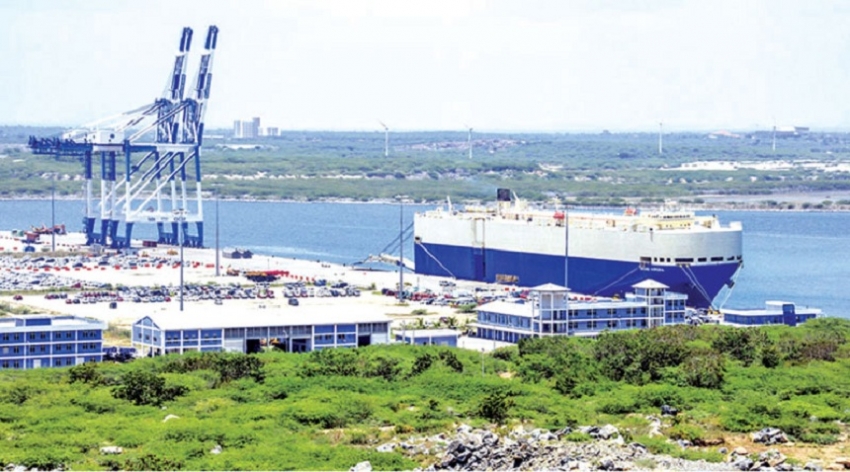The present regime led by President Gotabaya Rajapaksa and Prime Minister Mahinda Rajapaksa is committed to facilitating and promoting investments that suit modern business needs in the Hambantota District. Prospective investors will be encouraged to obtain the maximum use of the untapped investment opportunities in the Hambantota District.
First-time investors can contact sources at the Board of Investment (BOI) branch in the 12-storied building of the Hambantota Port for further information on business opportunities and the investment climate in Hambantota. The BOI has several initiatives to reduce the time taken for the approval process and resolve issues of investors efficiently thereby assisting investors to navigate the necessary administration processes at the shortest possible time. These consist of several high-level committees which meet at regular intervals to accommodate investors’ needs with the sole purpose of expediting cross-functional representation of the BOI which immediately screens all investment applications jointly across the relevant departments to grant approval expeditiously.
Hot springs in Madunagala
Any project which needs further clearance on operational issues will be referred to this high-level committee which is chaired by a senior advisor to the Prime Minister. The matters requiring policy-level interventions are referred to this committee chaired by the Secretary to the Treasury for speedy resolution.
The Hambantota Port faces the southern Indian Ocean with easy access to the international shipping routes about 10 nautical miles away. This international port is a joint venture between China Merchants Port Holdings (CM Port) and the Sri Lanka Ports Authority (SLPA). Its development covers an area of 11.51 square kilometres. Sources at the Hambantota branch of the BOI said the following are the investment opportunities in Hambantota Port.
The Hambantota District possesses all ingredients necessary for the promotion of eco-tourism. Tourism here is not just sun, surf and sandy beaches; variety is the keyword. The diversity of nature is most apparent in the abundant nature and wildlife reserves and sanctuaries. Bird watching and observing wildlife are other attractions that are extensively available, but not yet fully developed or exploited. This potential will awaken investor interest
Break-bulk terminals, container terminals and RO terminals and ship repair, ship chandling, warehousing for export-oriented manufacturing, heavy industries that require port and jetty facilities, export-oriented oil refinery, a power plant and a cement plant are included in the Hambantota Port.
The BOI office situated at the ten-storied administration complex provides all necessary information for prospective investors exploring available investment opportunities or seeking to expand their investment portfolios.Cashew apple is a waste product in the industry at the moment. Syrup or juice could be extracted and canned or bottled to produce a ready-to-serve drink. Its juice can also be converted into cashew wine by fermentation, and all waste material coming from the processing of juice or wine could be converted into vinegar.
Large-scale cashew processing has not been currently undertaken in the Southern Province. Large-scale cashew processing is undertaken in Colombo and its environs to which cashew nuts are sold in bulk; small-scale, domestic-level processing of cashew is carried out in the Hambantota and Matara Districts.The bulk of cow’s milk produced in the Hambantota District is sold elsewhere for processing, pasteurising and sterilising using modern technology. Only a small portion of milk is used by producers in the southern region to produce yoghurt and ready-to-serve drinks using simple modern technology.
In a few fruit-processing centres found in the southern area, mango and wood apple are processed into ready-to-serve drinks and jams. However, the bulk of this raw material is sold to large fruit-processing factories in Colombo and its environs.The existing cold storage facilities in the Hambantota District are not sufficient, and hence, there is a great potential for the establishment of ice plants and cold storage facilities in the the District. Not only the fisheries industry serving internal markets, but also the exporters of fish and other marine and aquatic products require these services. In addition, the processing industries which produce fruit and agricultural products too require cold storage facilities.
Hambantota is the central and ideal base to be promoted as an international location for eco-cultural tourism. The districts surrounding Hambantota too have sites to complement each other and maximize the use of time, energy and money.The Hambantota District possesses all ingredients necessary for the promotion of eco-tourism. Tourism here is not just sun, surf and sandy beaches; variety is the keyword. The diversity of nature is most apparent in the abundant nature and wildlife reserves and sanctuaries. Bird watching and observing wildlife are other attractions that are extensively available, but not yet fully developed or exploited. This potential will awaken investor interest.
Among the many tourist attractions in the Hambantota District are Sri Lanka’s first safari aprk in Ridiyagama, Sri Lanka’s first-ever Agro Technology Park at Bataatha in Hungama, Sri Lanka’s first-ever dry zone botanical garden in Mirijjawila, Yala National Park, Bundala National Park and the blowhole.The historic and prehistoric monuments and ruins in Mulkirigala, Devinuwara, Sithulpawwa, Tissamaharama, Buduruwagala, Kataragama and Kirinda and the colonial monuments such as the fortresses and towers in and around Galle, Matara and Hambantota add attraction to the area.
The Yala and Bundala national parks and Lunugamwehera Sanctuary are located in and around Hambantota. The historical sites of the Ruhunu dynasty, the Hindu Kovil in Kataragama, Buddhist temples, sylvan shrines, hot springs in Madunagala and the blowhole are all clustered near and along the borders of the Hambantota District.
The Madunagala hermitage is situated on a rock within the Karabagala and Madunagala forest reservations about 20 kilometres away from Ambalantota on the road to Suriyawewa via Koggala. Originally, this area was known as Mahapelessa.The present regime under the leadership of President Gotabaya Rajapaksa and Premier Mahinda Rajapaksa has taken special steps to boost the tourism industry in Hambantota that was neglected by the previous government which only made the country debt-ridden.




















